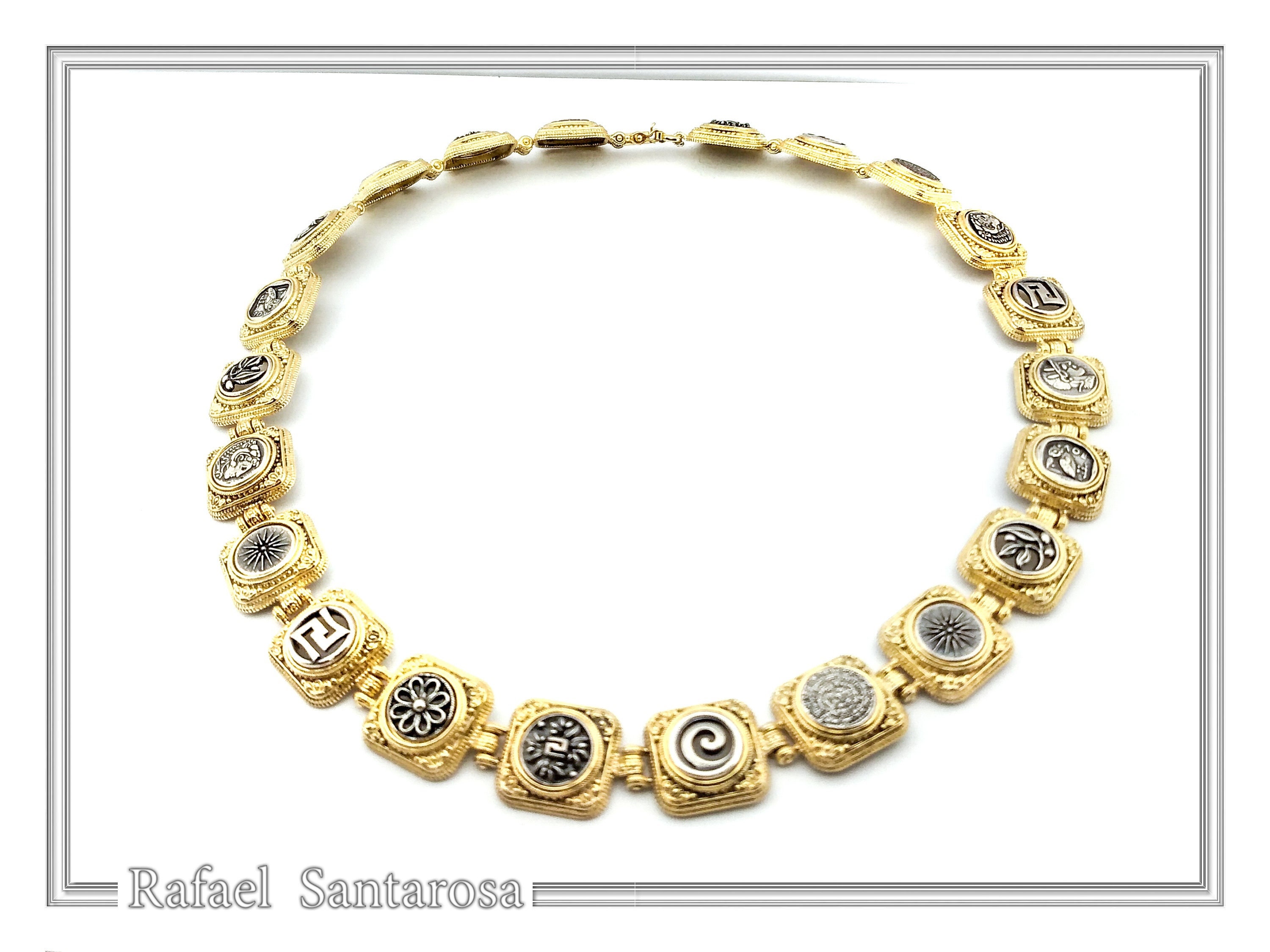
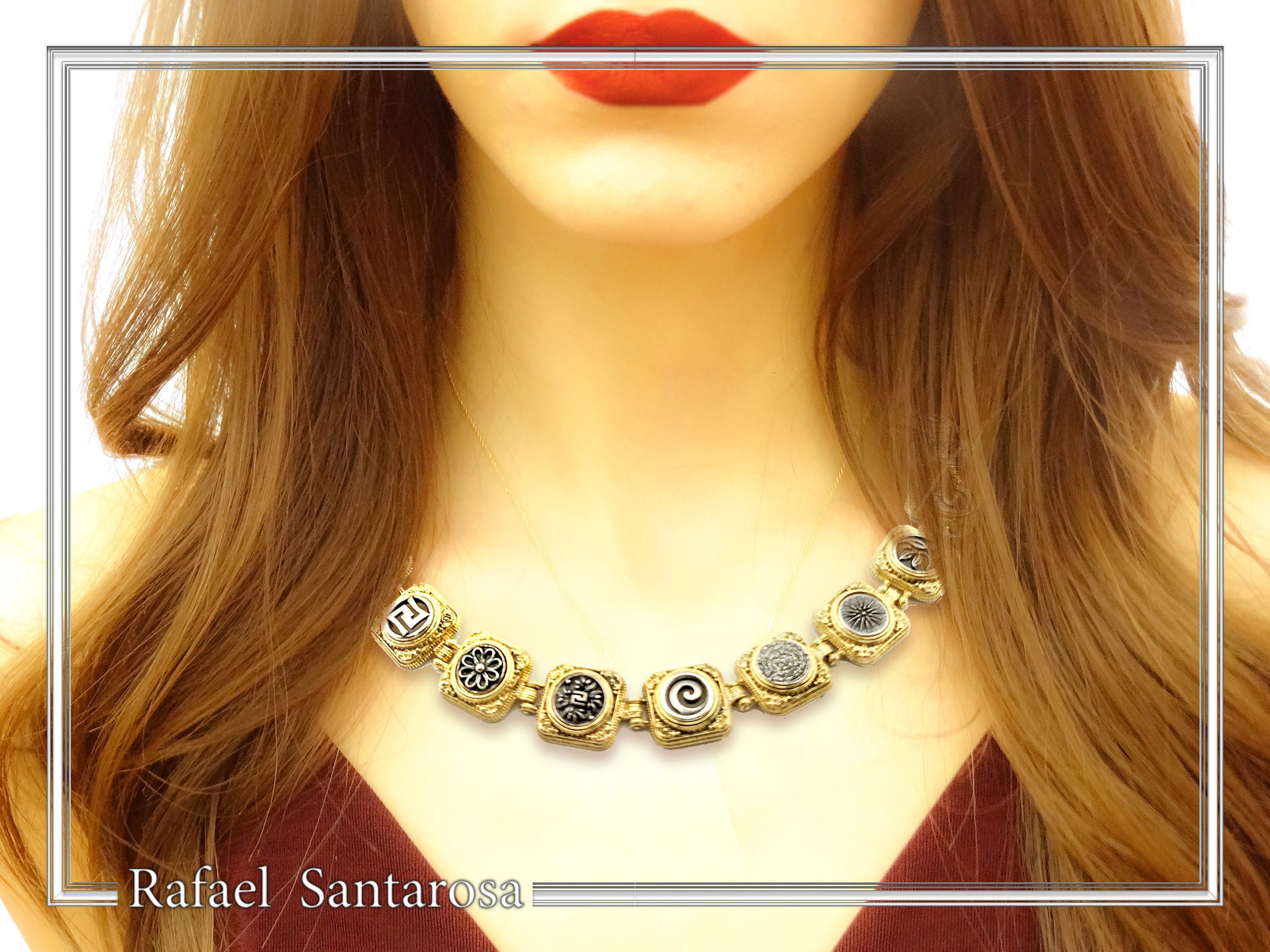
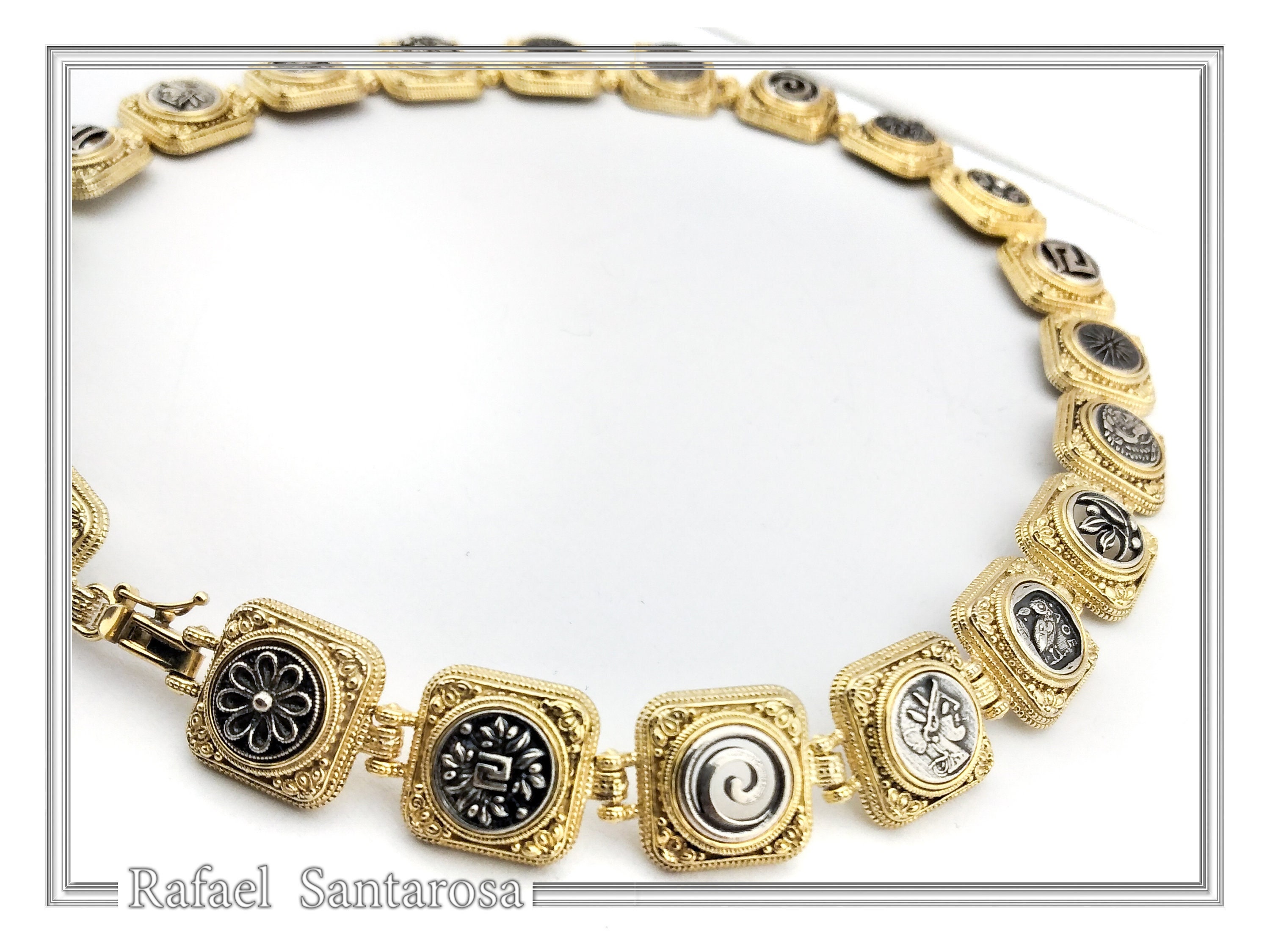


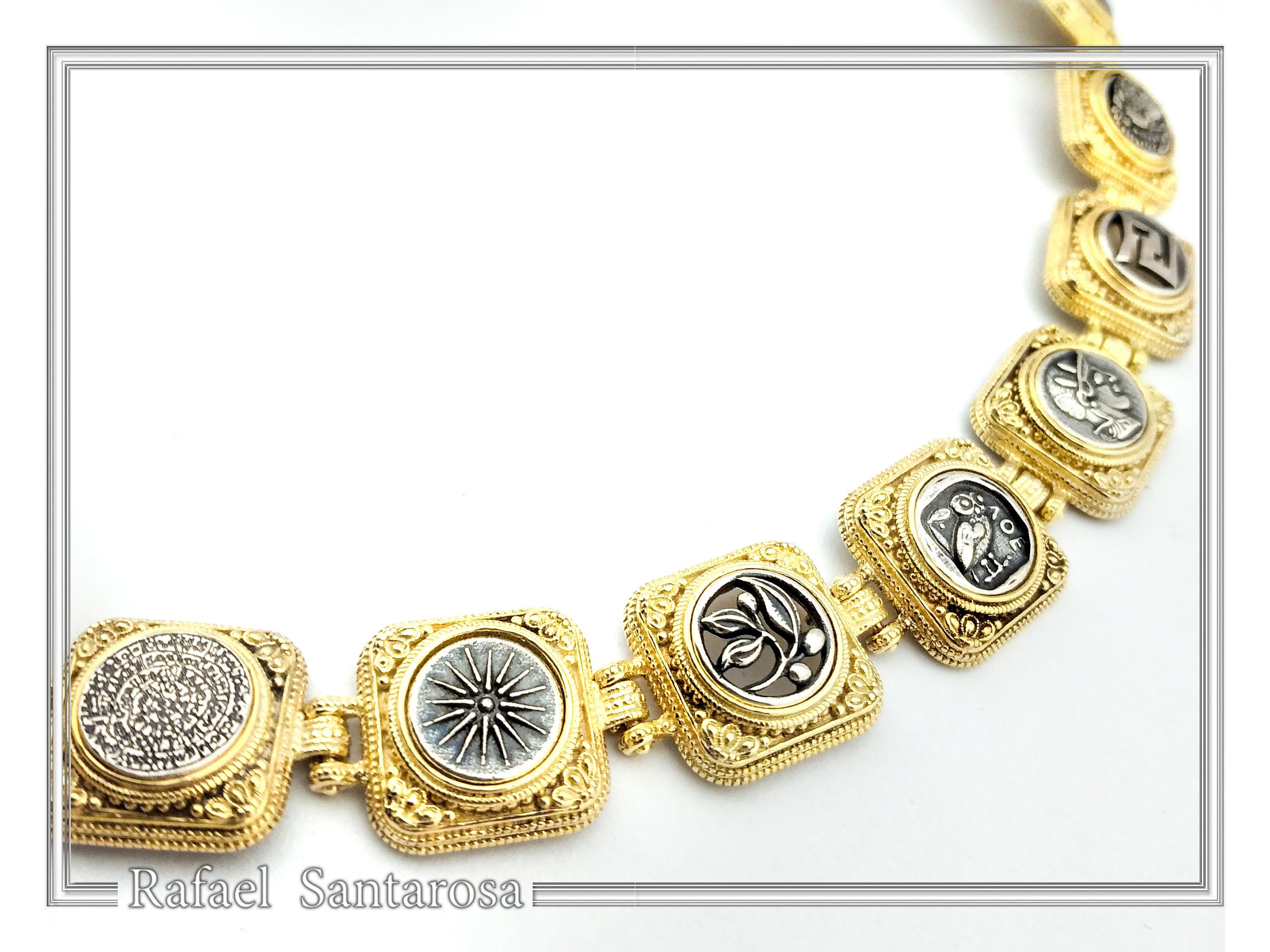
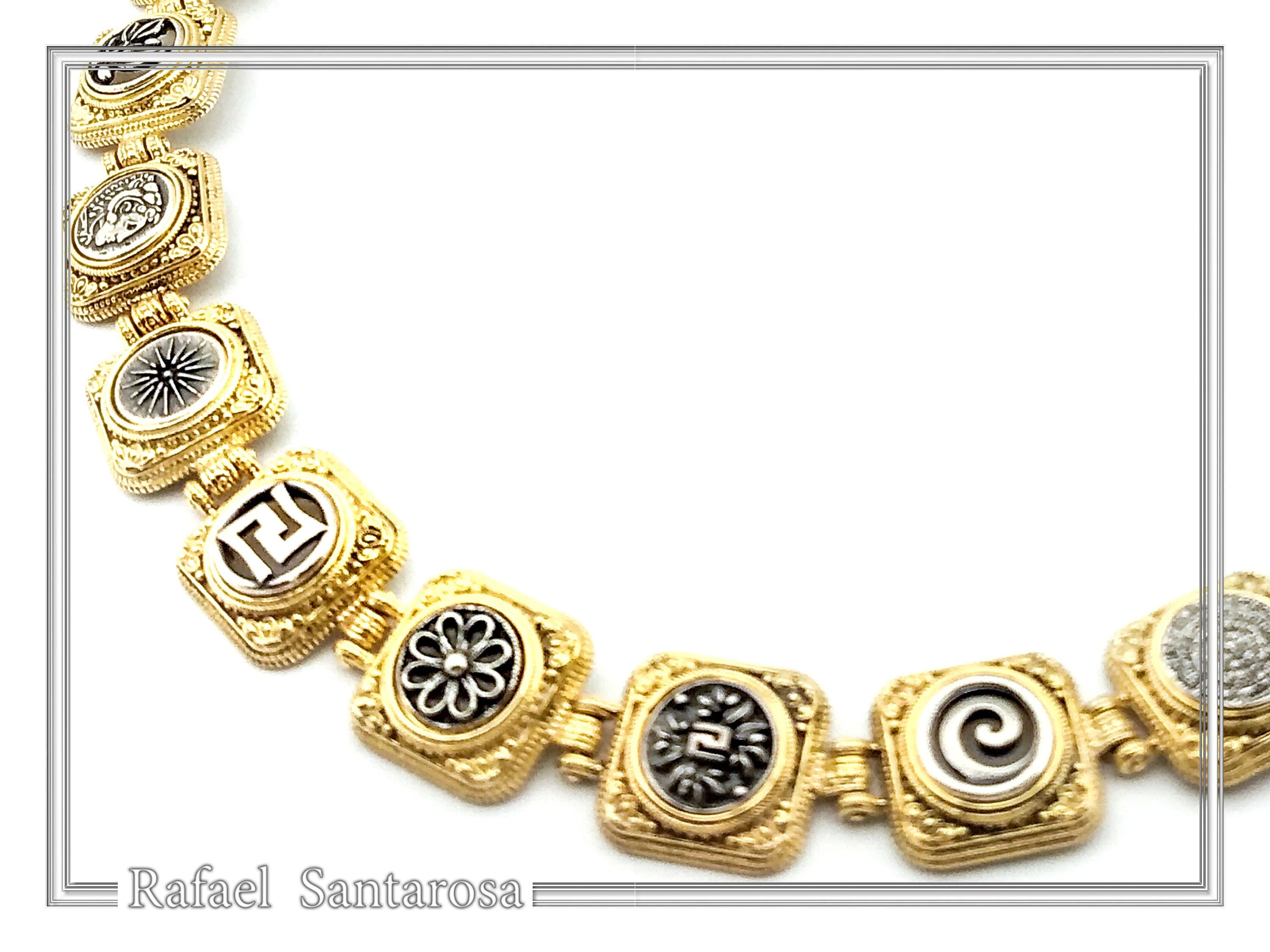

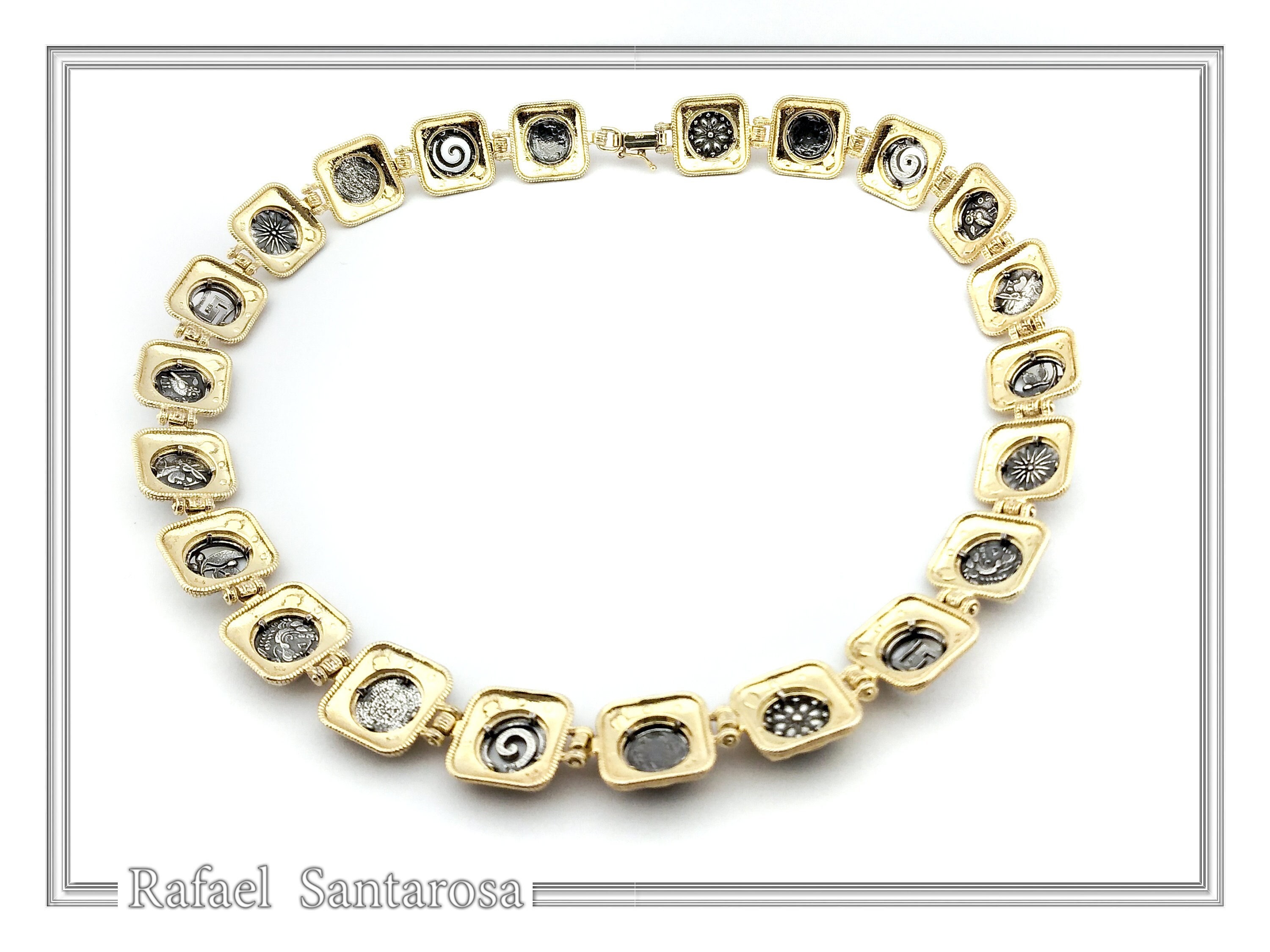
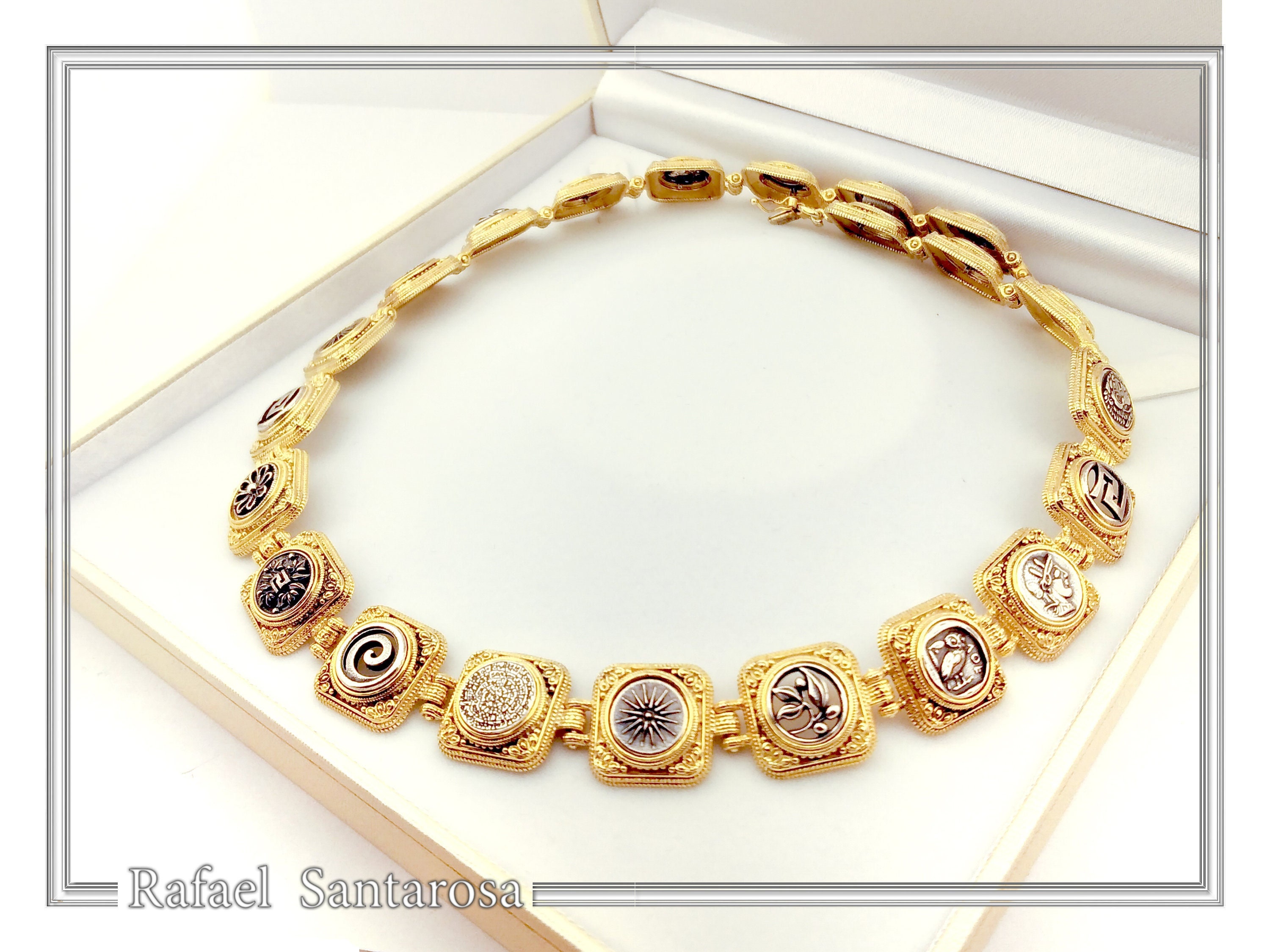
Beaded necklace filigree sterling silver 18 karat gold filled with oxidized silver ancient greek coins on the beads, classic museum replicas
$832.74 $1,110.32
Graduation gift. A heavy beaded necklace made of Sterling silver 18 karat gold-filled with oxidized silver ancient Greek coins museum replicas and filigree and granulation gold filled decoration. Owl, Athena, Alexander the Great, Pegasus, Greek key, Greek rodax, spiral, olive branch, Phaistos disc, Vergina sun, oxidized sterling silver coins, set in the middle of a square gold-filled silver bead with ancient greek filigree decoration, formed this classic beaded necklace, designed to resurrect the Greek glory of the golden age.
1. The ancient coin Athenian Tetradrachmon iconizing the profile of goddess Athena and therefore her devoted town of Athens. It is the representation of Athena as the Goddess of wisdom and knowledge. Made Nowadays it still stands as a symbol of town of modern Athens. Known as the Athena Minerva, this symbol has, since past times, indicated knowledge, wisdom, perspicacity, and erudition in the western world. "AOE" of Tetradrachmon in Ancient Greece means, "of the Athenians."
2. Owl is the symbol of wisdom and knowledge. Made of oxidized sterling silver coin set in a K18 gold filled sterling silver base. In Greek mythology, a little owl (Athene noctua) traditionally represents or accompanies Athena, the virgin goddess of wisdom, or Minerva, her syncretic incarnation in Roman mythology. Because of such association, the bird—often referred to as the "owl of Athena" or the "owl of Minerva"—has been used as a symbol of knowledge, wisdom, perspicacity and erudition throughout the Western world. Owl is the bird often Silver tetradrachm coin at the Archaeological Museum of the city of Athens depicting the owl of Athena (circa 480–420 BC). The inscription "ΑΘΕ" is an abbreviation of ΑΘΗΝΑΙΩΝ, which may be translated as "of the Athenians". In daily use the Athenian drachmas were called glaukes (γλαῦκες, owls). This silver coin was first issued in 479 BC in Athens after the Persians were defeated by the Greeks referred to as the "owl of Athena" or the "owl of Minerva" throughout the Western world. Nowadays it still stands as a symbol of town of modern Athens.
3. Tetradrachm (Coin) Portraying Alexander the Great as Herakles Certainly the best-known face in antiquity was that of Alexander the Great (reigned 336–323 BCE), whose profile, seen in this coin here, graced coins for two hundred years. He collected the treasure of conquered kingdoms as he swept across the Near East, and with this rich booty he set up mints that produced coins bearing his portrait.
4. Alexander the Great as Ammon-Ra. Ammon, eventually Amon-Ra, was a deity in the Egyptian pantheon whose popularity grew over the years, until growing into a monotheistic religion in a way similar to the proposal that the Judeo-Christian deity evolved out of the Ancient Semitic pantheon. Egyptian pharaohs came to follow this religion for a while, Amenhotep and Tutankhamun taking their names from their deity. This trend caught on, with other Egyptian gods also sometimes being described as aspects of Amon. Ammon was often depicted with ram's horns, so that as this deity became a symbol of supremacy, kings and emperors came to be depicted with Horns of Ammon on the sides of their head in profile, as well as the deities not only of Egypt, but other areas, so that Jupiter was sometimes depicted as "Jupiter Ammon", replete with Horns of Ammon, after Rome conquered Egypt, as was the Greek supreme deity Zeus. This tradition continued for centuries, Alexander the Great being referred to in the Quran as "The two-horned man", a reference to his depiction on middle eastern coins and statuary as having horns of Ammon. His deification as a conqueror had involved being declared "Son of Ammon" by the Oracle at Siwa.
5. The Vergina Sun (Greek: Ήλιος της Βεργίνας, Romanized: Ilios tis Verginas, lit. 'Sun of Vergina'), also known as the Star of Vergina, Vergina Star or Argead Star, is a rayed solar symbol first appearing in ancient Greek art of the period between the 6th and 2nd centuries BC. The Vergina Sun proper has sixteen triangular rays, while comparable symbols of the same period variously have sixteen, twelve, eight or (rarely) six rays. The name "Vergina Sun" became widely used after the archaeological excavations in and around the small town of Vergina, in northern Greece, during the late 1970s. In older references, the name "Argead Star" or "Star of the Argeadai" is used for the Sun as the possible royal symbol of the Argead dynasty of the ancient kingdom of Macedonia. There it was depicted on a golden larnax found in a 4th-century BC royal tomb belonging to either Philip II or Philip III of Macedon, the father and half-brother of Alexander the Great, respectively. Tentatively interpreted as the historical royal symbol of ancient Macedonia, rather than just a generic decorative element in ancient Greek art, the Vergina Sun came into popular use among Macedonian Greeks since the 1980s and became commonly used as an official emblem in the Greek region of Macedonia, and by other Greek state entities during the 1990s.
6. The Phaistos Disc is a disk of fired clay from the Minoan palace of Phaistos on the island of Crete. Now, the island of Crete is part of modern Greece. The disc was discovered in 1908 by the Italian archaeologist Luigi Pernier in the Minoan palace-site of Phaistos. While it is not clear that it is a script, most attempted decipherments assume that it is most additionally assume a syllabary, others an alphabet or logography or a calendar. ''The inscription was performed by pressure of preformed hieroglyphic seals on the soft clay, in a spiral sequence towards the center of the disc. This was then cooked at high temperature. Some archaeologists assume that the writing of Festos' disc is Minoan, but it is neither linear A nor linear B. Approximately 10 signs of the disc are similar to signs of linear writing. For this reason, other specialists attribute a non-Cretan origin to it. For example, according to the "protojonic" theory, the album would be the work of a Cycladic people. Yves Duhoux (1977) dates it between 1850 and 1650 a. C., based on Pernier's report indicating that the album was found in an unchanged Middle Minoan context. Jeppesen (1963) places it after 1400 a. C., based on a mis translation of Pernier's report. Doubting the feasibility of Pernier's report, Louis Godart (1990) merely admits that archaeologically the disc can be dated at any time from the middle and late Minoan eras. J. Best (in Achterberg et al. 2004) suggests a date in the first half of the fourteenth century a. C., founding it in its dating of the PH1 tablet found along with the disc. Dr. Jerome M. Eisenberg, editor-in-chief of minerva, The International Review of Ancient Art & Archaeology, published an article stating bluntly that the album is a fraud. According to Eisenberg, the album would be the work of his supposed discoverer, Luigi Pernier. There are 61 "words", made with 45 distinct signs, 31 on side A and 30 on side B, numbered A1 to A31 and B1 to B30, respectively, from the outside in which they appear to constitute a syllabary instead of an alphabet5 . The following transcription is a reading in that order (with the signs "head feathered" at the beginning of the words and cross marks at the end). The shortest word has two symbols, and the longest seven. Marks or strikethroughs are transcribed here as forward slashes (/). The transcription begins on the five-point vertical line, circulating once along the edge of the disc clockwise (13 words in A, 12 in B) before continuing spiraling toward the center (18 more words on each side). The final sign of a word in A8 is erased; Godart notes that it might look like signs 3 or 20. Evans considered the A-side to be the front, but since then new technical arguments have been inclined to think that the front side is the B. It should be mentioned that the sense of reading is one of the classic topics of discussion among specialists. The outdoor reading mentioned in the previous paragraph is not the most accepted, much less. The transcription signs shown below are oriented from left to right (or right to left, if reading begins at the center of the spiral instead of its outer edge), and can be read following the direction of the profiles of human and animal figures as read by anatolian hieroglyphics. But in Egyptian it reads against, that is, the other way around. So following the Egyptian system would justify reading the disc from the outside inwards. It is estimated that the album was created about 1750 a.C., which would make it the first written document in history. Instead of being hand-engraved as the writings of Linear A and Linear B of Crete the disc was printed on soft clay which was then hardened when cooked by 45 embossed stamps. The manufacture of such seals must have been very laborious, so it follows that the holder had to make quite a few texts and faster than if he did them. It could therefore be said to be a precursor to the different types of printing used in China 2500 years later and in medieval Europe 3100 years later.''
7. Pegasus is a mythical winged divine horse. Pegasus is the offspring of the Olympian god Poseidon. He was foaled by the Gorgon Medusa upon her death, when the hero Perseus decapitated her. Pegasus was caught by the Greek hero Bellerophon, with the help of Athena and Poseidon. Pegasus allowed Bellerophon to ride him in order to defeat the monstrous Chimera. Bellerophon later fell from the winged horse's back while trying to reach Mount Olympus. Afterwards, Zeus transformed Pegasus into the eponymous constellation.
8. Spiral is the ancient greek symbol of eternity.
9. A sphinx is a mythical creature with the head of a human, a falcon, a cat, or a sheep and the body of a lion with the wings of a falcon. In Greek tradition, the sphinx has the head of a woman, the haunches of a lion, and the wings of a bird. She is mythicized as treacherous and merciless and will kill and eat those who cannot answer her riddle. This deadly version of a sphinx appears in the myth and drama of Oedipus. Unlike the Greek sphinx, which was a woman, the Egyptian sphinx is typically shown as a man (an androsphinx (Ancient Greek: ανδρόσφιγξ)). In addition, the Egyptian sphinx was viewed as benevolent but having a ferocious strength similar to the malevolent Greek version. Both were thought of as guardians and often flank the entrances to temples. In European decorative art, the sphinx enjoyed a major revival during the Renaissance. Later, the sphinx image, initially very similar to the original Ancient Egyptian concept, was exported into many other cultures, albeit they're often interpreted quite differently due to translations of descriptions of the originals and through the evolution of the concept in relation to other In the Bronze Age, the Hellenes had trade and cultural contacts with Egypt. Before the time that Alexander the Great occupied Egypt, the Greek name, sphinx, was already applied to these statues. The historians and geographers of Greece wrote extensively about Egyptian culture. Herodotus called the ram-headed sphinxes Criosphinxes and called the hawk-headed ones Hieracosphinxes.[citation needed] The word sphinx comes from the Greek Σφίγξ, associated by folk etymology with the verb σφίγγω (sphíngō), meaning "to squeeze", "to tighten up". This name may be derived from the fact that lions kill their prey by strangulation, biting the throat of prey and holding them down until they die. However, the historian Susan Wise Bauer suggests that the word "sphinx" was instead a Greek corruption of the Egyptian name "shesepankh", which meant "living image", and referred rather to the statue of the sphinx, which was carved out of "living rock" (rock that was present at the construction site, not harvested and brought from another location), than to the beast itself. Apollodorus describes the sphinx as having a woman's face, the body and tail of a lion and the wings of a bird. Pliny the Elder mentions that Ethiopia produces plenty of sphinxes, with brown hair and breasts, corroborated by 20th century archeologists. Statius describes her as a winged monster, with pallid cheeks, eyes tainted with corruption, plumes clotted with gore and talons on livid hands. Sometimes, the wings are specified to be those of an eagle, and the tail to be serpent-headed.[citation needed] There was a single sphinx in Greek mythology, a unique demon of destruction and bad luck. According to Hesiod, the Sphinx—here called "Phix" (Φῖκ’)—was a daughter of Orthrus and either the Chimera (probably) or Echidna (or perhaps even Ceto). According to Apollodorus and Lasus, she was a daughter of Echidna and Typhon. The sphinx was the emblem of the ancient city-state of Chios, and appeared on seals and the obverse side of coins from the 6th century BCE until the 3rd century CE.cultural traditions. Sphinx depictions are generally associated with architectural structures such as royal tombs or religious temples. The Sphinx is said to have guarded the entrance to the Greek city of Thebes, asking a riddle to travellers to allow them passage. The exact riddle asked by the Sphinx was not specified by early tellers of the myth, and was not standardized as the one given below until late in Greek history. It was said in late lore that Hera or Ares sent the Sphinx from her Aethiopian homeland (the Greeks always remembered the foreign origin of the Sphinx) to Thebes in Greece where she asked all passersby the most famous riddle in history: "Which creature has one voice and yet becomes four-footed and two-footed and three-footed?" She strangled and devoured anyone who could not answer. Oedipus solved the riddle by answering: "Man—who crawls on all fours as a baby, then walks on two feet as an adult, and then uses a walking stick in old age". By some accounts (but much more rarely), there was a second riddle: "There are two sisters: one gives birth to the other and she, in turn, gives birth to the first. Who are the two sisters?" The answer is "day and night" (both words—ἡμέρα and νύξ, respectively—are feminine in Ancient Greek). This second riddle is also found in a Gascon version of the myth and could be very ancient. Bested at last, the Sphinx then threw herself from her high rock and died; or, in some versions Oedipus killed her. An alternative version tells that she devoured herself. In both cases, Oedipus can therefore be recognized as a "liminal" or threshold figure, helping affect the transition between the old religious practices, represented by the death of the Sphinx, and the rise of the new, Olympian gods. 10.
Greek key the symbol of eternity known as Meandrous, from the name of a river of Asis Minor with the same shape.
11. Rodax, Greek rose flower. Roses are widely used across the world as symbols of love, sympathy or sorrow. Rose is widely used as a girl's name. The rose was sacred to Venus (mythology). Venus was the Roman goddess of love and beauty. It was also linked with Cupid (son of Venus). He was the Roman god of desire – in one myth, he dropped nectar and the nectar bubbled up from the ground as roses. The rose was also sacred to Bacchus. He was the Roman god of wine. Rich Romans would lie on couches with roses laid on them. They would wear roses tied onto string around their neck. Anything which was said "under the rose" was considered to be a secret. Cleopatra VII of Egypt was said to have had a floor of her palace covered in roses before her lover Mark Antony visited her.
Thanks for visiting my shop.
My name is Athanasios, I live in Greece, and I design, and I handcraft Jewelry based on ancient and Byzantine Greek tradition. My workplace is established on the holy mountain Parnassus, near the center of the earth, the Delphi ancient Greek secret holy city.
Please feel free to message me for any information, help or request
If we are in a different time zone, please be patient, we will get back to you as soon as possible.
The photographs of our products are not professional. They are taken by me and uploaded in a logo frame to assure you that is my own proprietary because I am the designer and manufacturer and not a reseller.
DELIVERY IS FREE WORLDWIDE.
Delivery is done immediately by the most efficient way appropriate for your country. FedEx Express, DHL Express and Hellenic Post are the most common. All items are shipped from Athens, Greece and under normal circumstances are delivered from 2 to 7 business days worldwide. Don't forget to message me a phone number after buying a jewel. Is very valuable for the courier to ensure that can easily communicate with you for the safe delivery in the appropriate time.
When shipment is complete you will receive a message through Etsywith information about the carrier and your tracking code.
We use only natural gemstones. Our pearls are always freshwater quality.
On the jewelry set with gemstones, please read our descriptions to understand which gems have been used.
Since we sell to an international market our sizing measurements are either in the metric system or in American standards. If you are not familiar with our sizing, please ask. Ring sizes are in the US and lengths or widths are in centimeters.
Our prices are listed in Euros. Etsyis responsible for conversion rates listed in your respective currencies. If you see differences from one day to another it could mean different exchange rates.
Stay with us for more handmade jewelry here https://www.etsy.com/your/shops/RafaelSantarosa.
Frequently asked questions
Gift wrapping and packaging.
All items are shipped in a hard jewelry, gift box and are ready to be offered in a linen pouch as gifts. The box is placed in a bubble envelope for shipping.
Care instructions
All jewelry is made from sterling silver 925 or solid gold and can be worn 24 hours a day.
A bit of care is needed for the gold plated or gold-filled items, where continuous contact with water or perfumes will gradually fade away the plating.
Shipping
Each item has its own processing time even though for most items I have at least one available for immediate shipping.
All items have free international shipping with DHL express or with Greek Postal Service (ELTA).
Sizing details
Each country has its own scaling system, so we use many scales on our product listings. If you are not familiar with our sizing, please ask.
Ring sizes are in the US sizing system.
and lengths or widths are in centimeters.
One inch is 2.54cm
Enjoy your jewelry.
Shipping from Greece
Processing time
1-3 business days
Customs and import taxes
Buyers are responsible for any customs and import taxes that may apply. I'm not responsible for delays due to customs.
Payment Options
Returns & Exchanges
I gladly accept returns, exchanges, and cancellations
Just contact me within: 3 days of delivery
Ship items back to me within: 7 days of delivery
Conditions of return
Buyers are responsible for return shipping costs. If the item is not returned in its original condition, the buyer is responsible for any loss in value.
Questions about your order?
Please contact me if you have any problems with your order.
Privacy policy
Dear customer
the Information we collect is necessary to fulfil your order, you must provide us with certain information (which you authorized Etsy to provide to us), such as your name, email address, postal address, payment information, and the details of the product that you’re ordering. You may also choose to provide us with additional personal information (for a custom order of jewelry, for example), if you contact us directly.
We underline here that you must provide your affirmative consent to use your pessonal data for our mailing list by signing up, which therefore, you may revoke at any time by unsubscibing ;
2. Based on the GDPR policy we need to collect, use, and share your information for the following reasons:
1. to provide my services,
2. to fulfil your order,
3. to settle disputes, or to provide customer support;
4. to comply with a legal obligation or court order or in connection with a legal claim, if necessary,
5. to retain information about your purchases if required by tax law
as necessary
and last but not least for the purpose of our legitimate interests;
if those legitimate interests are not overridden by your rights or interests or obligations with the Etsy contract we already have signed such as
1) providing and improving my services. We use your information to provide the services you requested and in our legitimate interest to improve our services;
2) Compliance with the Etsy Seller Policy and Terms of Use. We use your information as necessary to comply with our obligations under the Etsy Seller Policy and Terms of Use.
Information Sharing and Disclosure
Information about our customers is important to our business. We share your personal information for very limited reasons and in limited circumstances, as follows:
Etsy. We share information with Etsy as necessary to provide you our services and comply with my obligations under both the Etsy Seller Policy and Etsy Terms of Use.
Service providers. We engage certain trusted third parties to perform functions and provide services to our shop, such as delivery companies. We will share your personal information with these third parties, but only to the extent necessary to perform these services.
Business transfers. If we sell or merge our business, we may disclose your information as part of that transaction, only to the extent permitted by law.
Compliance with laws. We may collect, use, retain, and share your information if we have a good faith belief that it is reasonably necessary to:
(a) respond to legal process or to government requests;
(b) enforce my agreements, terms and policies;
(c) prevent, investigate, and address fraud and other illegal activity, security, or technical issues;
(d) protect the rights, property, and safety of our customers, or others.
Data Retention
We retain your personal information only for as long as necessary to provide you with our services and as described in our Privacy Policy. However, we may also be required to retain this information to comply with our legal and regulatory obligations, to resolve disputes, and to enforce our agreements. We generally keep your data for the following time period: 5 years.
Transfers of Personal Information Outside the EU
We may store and process your information through third-party hosting services in the US and other jurisdictions. As a result, we may transfer your personal information to a jurisdiction with different data protection and government surveillance laws than your jurisdiction. If we are deemed to transfer information about you outside of the EU, we rely on Privacy Shield as the legal basis for the transfer, as Google Cloud is Privacy Shield certified.
Your Rights
If you reside in certain territories, including the EU, you have a number of rights in relation to your personal information. While some of these rights apply generally, certain rights apply only in certain limited casesas follows:
Access. You may have the right to access and receive a copy of the personal information we hold about you by contacting us using the contact information below.
Change, restrict, delete. You may also have rights to change, restrict our use of, or delete your personal information. Absent exceptional circumstances (like where we re required to store data for legal reasons) we will generally delete your personal information upon request.
Object. You can object to
(i) our processing of some of your information based on our legitimate interests and
(ii) receiving marketing messages from Us after providing your express consent to receive them. In such cases, We will delete your personal information unless We have compelling and legitimate grounds to continue using that information or if it is needed for legal reasons.
Complain. If you reside in the EU and wish to raise a concern about our use of your information (and without prejudice to any other rights you may have), you have the right to do so with your local data protection authority.
How to Contact Us
For purposes of EU data protection law, we, Rafael Santarosa Fine Jewellery, are the data controller of your personal information. If you have any questions or concerns, you may contact me at
rafaelsantarosa.lab@gmail.com.
Sincerely yours
Frequently Asked Questions
Gift wrapping and packaging
All items are shipped in a hard, jewelry, gift box and are ready to be offered as gifts. The box is placed in a bubble envelope for shipping.
Care instructions
All jewelry is made from sterling silver 925 or solid gold and can be worn 24 hours a day.
A bit of care is needed for the gold plated or gold filled items, where continuous contact with water or perfumes will gradually fade away the plating.
Wholesale availability
Several pieces of jewelry can be sold in larger quantities at wholesale prices. However,most items cannot be mass produced, so larger quantities will take more time and separate listings have to be created with different shipping times. Please contact us if you wish to purchase bulk.
Shipping
Each item has its own processing time even though for most items I have at least one available for immediate shipping.
All items have free international shipping with FedEx express, DHL express or with the Greek Postal Service (ELTA),
On items that are shipped in Greece , quicker, expedited ACS Greek courier, or DHL shipping is available.
Sizing details
Each country has it's own scaling system, so we use many scales on our product listings .If you are not familiar with our sizing please ask.
Ring sizes are in US or French
and lengths or widths are in centimeters or inches.
One inch is 2.54cm
